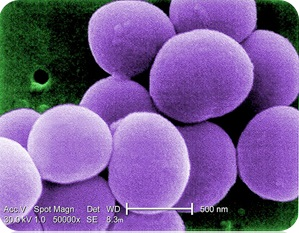Unit 9: Lesson 6: Infection
Lesson 6: Infection

Lesson 6: Infection
The risks of spreading infections in healthcare settings are an essential concern. In the United States alone, over 20,000 patients die each year from infections that they contracted while in a hospital or hospital-like setting. About 10% of all hospital patients each year (or about 2 million people in the US) will contract an infection while in the hospital. However, most of these individuals will recover, and many more patients are admitted to hospitals to receive treatment for infections they contracted daily. When individuals with infections – however the infections are acquired – are treated, there is the possibility that their infection could be spread to healthcare professionals and other patients, either directly or indirectly. Community-acquired infections are those that are contracted outside of a healthcare setting, and this includes strains of influenza and pneumonia. Nosocomial infections are those contracted within a healthcare setting. Methicillin-resistant Staphylococcus aureus (MRSA) is one example of a nosocomial infection.
A strain of Staphylococcus aureus bacteria under high magnification
Nosocomial infections occur in hospital settings for several reasons. First, healthcare settings, particularly hospitals, contain many pathogens within the setting. Patients come to the hospital for treatment, bringing bacteria, viruses, and other diseases. Second, hospitals and other healthcare settings contain more people with compromised immune systems, making them more susceptible to pathogens. Finally, healthcare settings are places where there are easy ways for an infection to be transferred from person to person if care isn't taken to prevent the infections from spreading.
The CDC recommends hand washing as one of the top ways to reduce and prevent community and nosocomial infections. Washing hands with soap removes most microbial flora from the hands and reduces transmission to other patients. Good hand washing involves using adequate soap, rubbing the hands together, and rinsing the hands under running water. Healthcare professionals should wash their hands as soon as possible after contact with blood, bodily secretions, and any equipment or other items that may have come into contact with a pathogen.
Another safety step that healthcare professionals can use is to wear gloves when working with a patient and to change gloves before working with another patient. This can reduce the likelihood of transmitting pathogens from the original patient to the healthcare professional or another patient. Hands should also be washed as soon as possible after gloves are removed in case the gloves have tears or minor defects that might have allowed a pathogen to move through the material. Equipment and other items should be disinfected before they are used with another patient. Disposable, single-use items can also help reduce the transmission of pathogens within a healthcare setting.
Stress
The health science field can be one of the most stressful areas of employment. Health science professionals may handle life-and-death situations, deal with complex workplace hierarchies, experience staff shortages and tight schedules, and witness patient deaths. These factors contribute to the stress that health science professionals often face.
Stress can be a problematic aspect to define, in part because stress is a normal reaction to threats and demands on our bodies and minds that go beyond our normal levels. One definition of stress is any aspect that threatens or challenges our well-being. While our stress response can be beneficial in extreme circumstances where we face danger, too often, people find themselves continually overloaded and pressured through their work and personal situations and tasks. Medical studies have demonstrated that stress can be associated with ulcers, migraines, difficulty sleeping, emotional issues, and an increased use of alcohol, tobacco, and other drugs.

Healthcare settings can do several things to help reduce stress for their employees. Education about stress and how to manage it can be one step in the process of reducing workplace stressors. In addition, healthcare settings can address some factors that may lead to stress, such as long work hours, understaffing, lack of resources, and unsafe equipment. Some healthcare facilities have provided counseling to employees and clear channels for workplace concerns and complaints, including those with senior staff members.
Individual health science professionals can use various techniques to manage and reduce stress. Relaxation and biofeedback techniques help relieve the symptoms of anxiety. Time management strategies can help balance work and family/social obligations. Health experts also recommend creating personal time and caring for yourself to help combat stressful situations.
In this unit, we learned more about joint health and safety issues that health science professionals may face. We identified some organizations that develop safety guidelines for the healthcare industry. We also identified some common risks to health science professionals in work settings and discussed ways to reduce these risks.
Think About
- Which organizations deal with safety and health issues related to the healthcare industry?
- What are some of the risks that exist for health scientists in their work?
- What are some of the methods that can be used to reduce risks in healthcare settings?
- What procedures should individuals follow in the event of a fire in a healthcare setting?
- What are ergonomics? How can ergonomics help reduce the risks of injury to healthcare workers?
